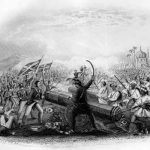FOUR BATTLES THAT CONDEMNED INDIA TO COLONIALISM
A ride through colonial history (Continued)
BATTLE OF GUJRAT 13 FEBRUARY 1849
Maharajah Ranjit Singh who consolidated the Sikh Empire in Northwest India during the early decades of 19th Century, about the same period as the British were expanding their hold over the rest of India, had maintained a friendly but cautious relationship with the latter, combining diplomacy with military might. He had built an excellent army using European and American trainers and the British found it prudent to keep their hands off his domain. His death in 1839 plunged the empire into disarray with power struggles, while the Sikh Khalsa Army expanded multifold, with the landlords and their retainers taking up arms, asserting itself as the embodiment of the Sikh nation. The British, alarmed, began building up their military strength in the neighbourhood of Punjab. Mutual suspicions led to the 4-month long 1st Anglo-Sikh War (1845 – 46) ending in partial British victory, primarily due to the treachery of some Sikh generals who were complicit in the power play at the Durbar (court). Consequently, the Sikh Empire had to cede territories to East India Company and accept its control of governance through a Resident at Lahore, the capital, though Maharajah Duleep Singh, only a child, retained the throne.
The British retained part of the Sikh Army to control the Muslim-inhabited areas lest those ally with Afghans or rebel. There was resentment within the army following the exile of Maharani Jind Kaur, the mother of Duleep Singh and former Regent, by the British as well as due to the reluctance of the Sardars (Generals) to take orders from younger British officers. The Dewan of Multan turned rebellious in April 1848 triggering large-scale desertions of troops to join the rebellion. With Multan under siege by the British, a rebel army under Sardar Sher Singh Attariwalla marched northward to Central Punjab in September, aiming to join forces with Sher Singh’s father and Governor of Hazara, Chattar Singh Attariwalla, who had openly revolted in August. He formed up in defence on the west bank of the river Chenab to confront Sir Hugh Gough, the Commander-in-Chief of the Bengal Army arriving with reinforcements in November, but fell back after winning a skirmish across the river, with Gough in pursuit. The two met in battle at Chillianwala near the river Jhellum on 13 January 1849. In the stiffly fought encounter during late afternoon Sher Singh got the better of Gough, though his own army was mauled badly too. While incessant rains during the next three days prevented further fighting, Sher Singh set off northward again. Soon with Gough in pursuit, he attempted a tactical manoeuvre by his cavalry crossing the Chenab and re-crossing it to hit Gough’s rear; which could not be accomplished with the river in spate. He was more or less trapped at Gujrat (town of Gujrat in Pakistani Punjab now) on the west bank of Chenab, where Gough attacked in strength on 13 February. By now Gough had been reinforced by an enormous amount of artillery and he brought his full firepower (about 100 guns) on the hastily entrenched Sikh Army. The Sikhs fought gallantly but the British firepower prevailed. Gujrat was lost, and so was the 2nd Anglo-Sikh War. With his force depleted, Sher Singh surrendered with his father (who had broken out of Hazara earlier in the year with some Afghan help) near Rawalpindi on 12 March 1849. The British annexed the Punjab, the last Indian bastion to fall. Yet another instance of factionalism and infighting bringing on the ruin of a sovereign state.
The Anglo-Sikh Wars however fostered mutual respect between the Sikhs and the British as worthy foes and eminent combatants. The Sikhs would in due course serve in large numbers under the British colours, contributing substantially in putting down the Sepoy Rebellion of 1857. The Bengal Sepoys who revolted had fought the Sikhs barely a decade ago, and the Sikhs found no reason to sympathize with them. And the sepoys proclaiming the defunct Mughal Emperor, Bahadur Shah Zafar, as their symbolic sovereign didn’t go well with the Sikhs at all. In fact the Sikh hatred for the Mughals dating back to their diabolic persecution by Emperor Aurangzeb was so deep that William Hodson is believed to have enthused them to enlist in the Hodsons Horse during the Sepoy Rebellion by promising them plenty of opportunity to kill ‘Aurangas’.
In later years, the large number of Sikhs who served in the British Indian Army in the two World Wars carved out a fierce reputation for themselves worldwide. Today substantial numbers of Sikhs serve in the British Army as well; which even relaxed its dress code to permit its Sikh Soldiers to wear turbans; a sign of the enormous respect the British hold for the martial prowess of the Sikhs. Signifying that martial bond like never before was Charanpreet Singh Lall, a 22-year old Sikh from Leicester, marching through London wearing a turban as a member of the Coldstream Guards for the Trooping of the Colour to mark Queen Elizabeth’s 92nd birthday earlier this month; the first time ever one of the guards wore a turban in the traditional ceremony that has marked the birthday of Britain’s sovereign for 260 years.
[The 4-blog series on battles that condemned India to colonialism ends with this]





